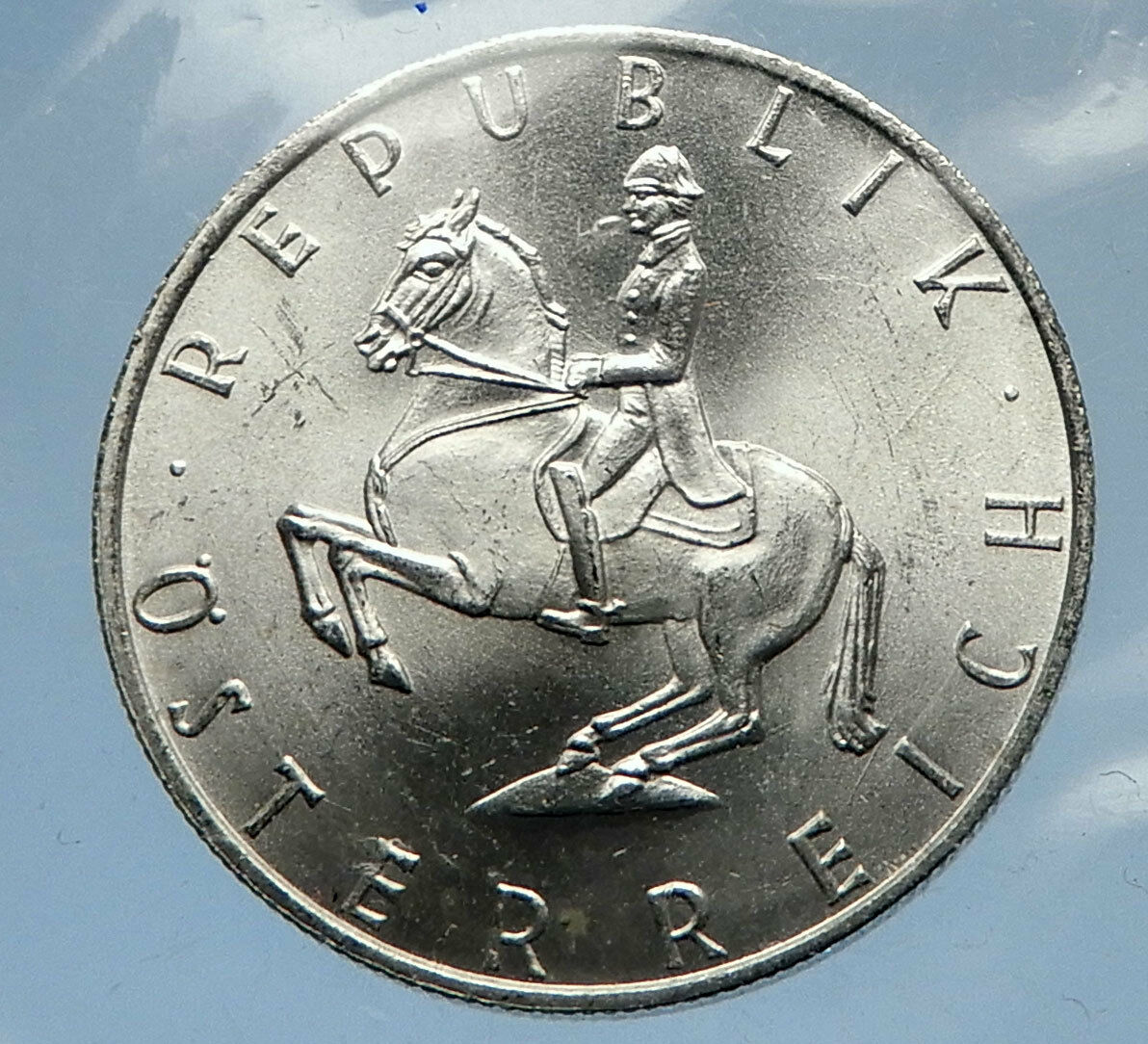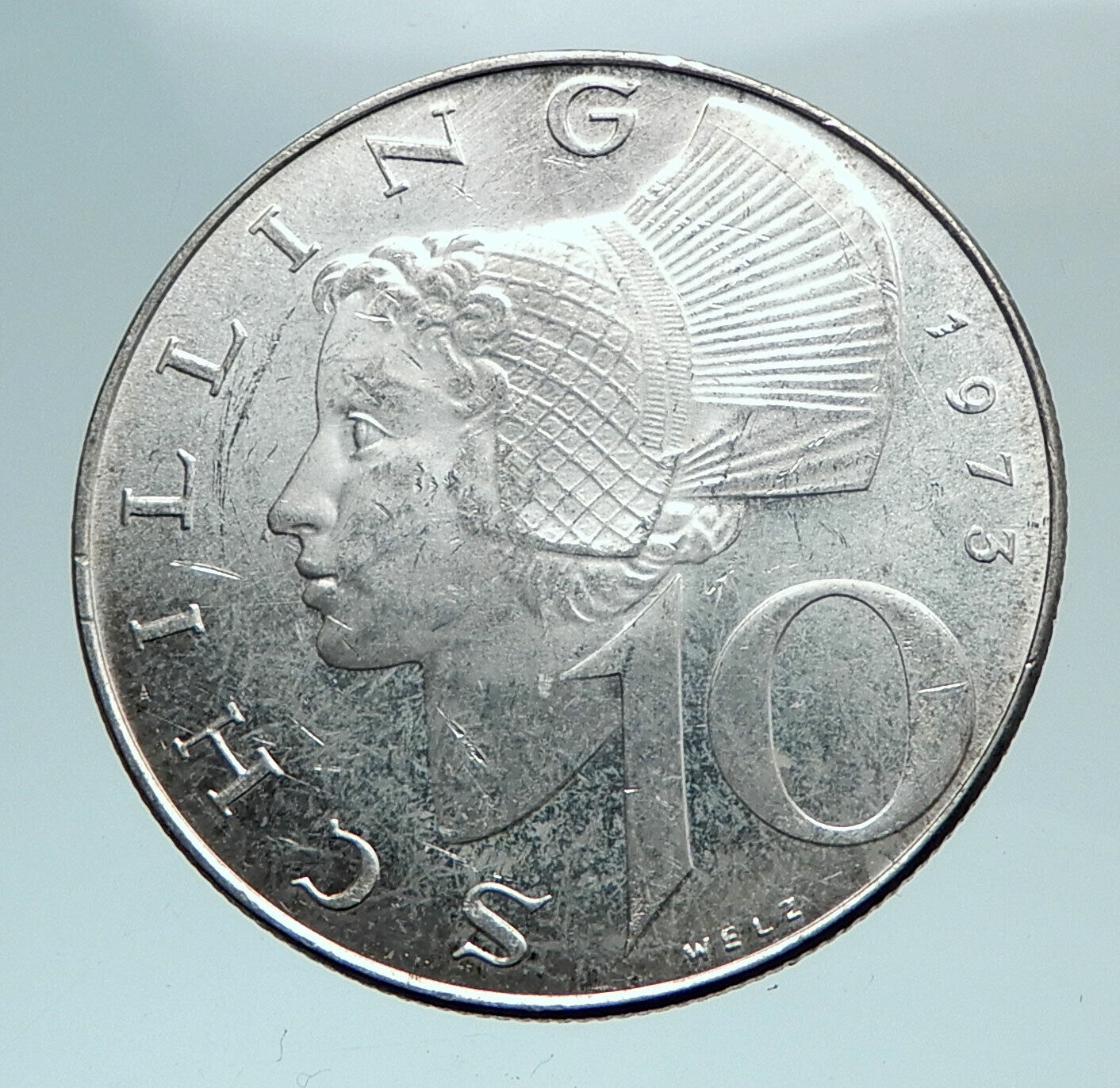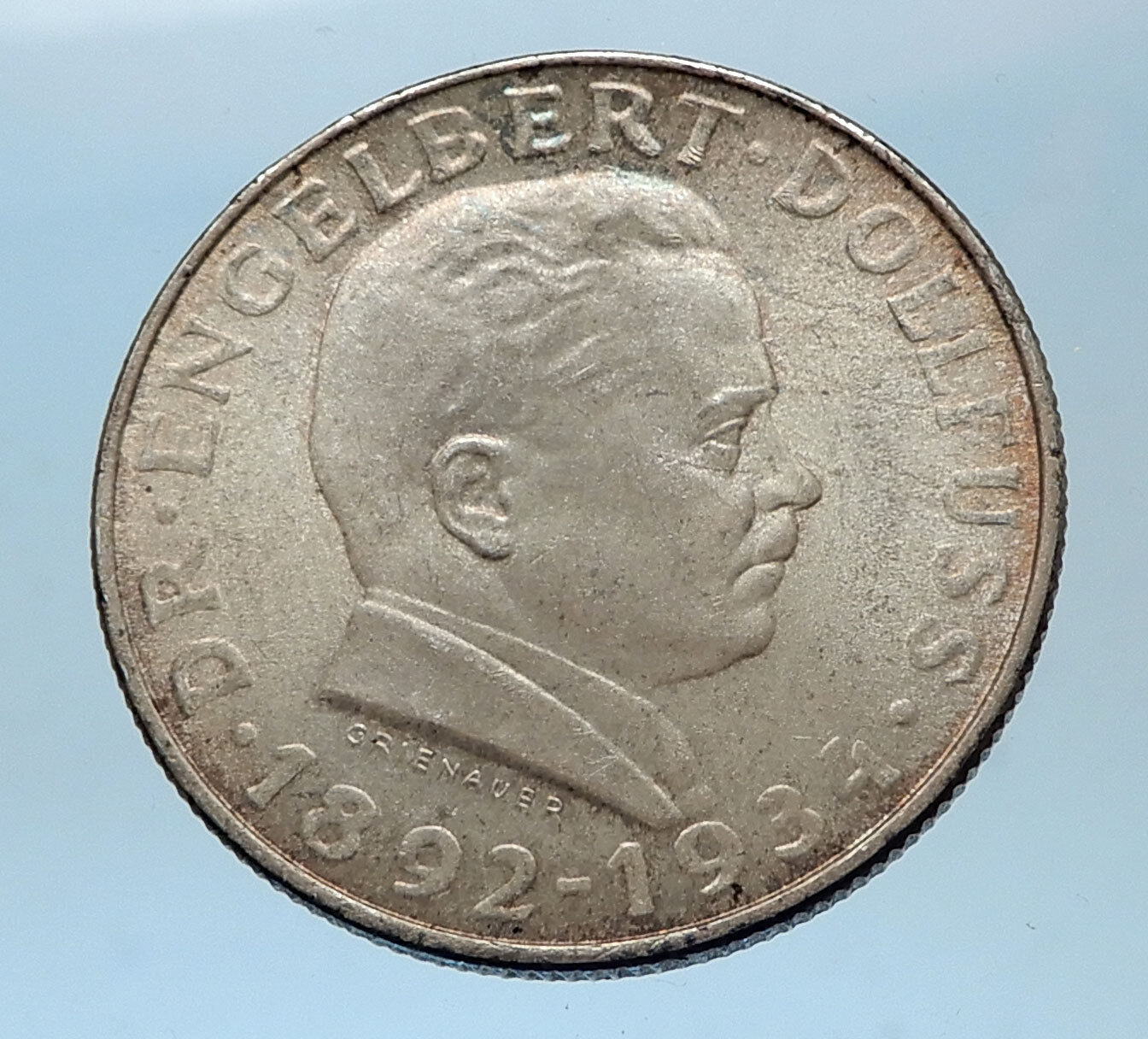|
Austria – 80th Anniversary of Julius Raab
1971 Silver 50 Schilling 34mm (19.92 grams) 0.900 Silver (0.5787 oz. ASW)
Reference: KM# 2911
1891 · ING · JULIUS RAAB · 1964 1971, Head of Julius Raab, right date below.
· REPUBLIK · 25 SCHILLING ÖSTERREICH, Value within circle of shields.
Edge Lettering: FUENFUNDZWANZIG SCHILLING
You are bidding on the exact item pictured, provided with a Certificate of Authenticity and Lifetime Guarantee of Authenticity.
 Julius Raab (29 November 1891 – 8 January 1964) was a conservative Austrian politician, who served as Federal Chancellor of Austria from 1953 to 1961. Raab steered Allied-occupied Austria to independence, when he negotiated and signed the Austrian State Treaty in 1955. In internal politics Raab stood for a pragmatic “social partnership” and the “Grand coalition” of Austrian Conservatives and Social Democrats. Julius Raab (29 November 1891 – 8 January 1964) was a conservative Austrian politician, who served as Federal Chancellor of Austria from 1953 to 1961. Raab steered Allied-occupied Austria to independence, when he negotiated and signed the Austrian State Treaty in 1955. In internal politics Raab stood for a pragmatic “social partnership” and the “Grand coalition” of Austrian Conservatives and Social Democrats.
Raab was born into a middle-class Catholic family in Sankt Pölten, Lower Austria, the son of a master builder. He attended a Catholic high school and in 1911 enrolled at the Vienna University of Technology to study civil engineering. He was drafted into the Austro-Hungarian Army as a pioneer officer before graduation and fought on the Russian and Italian fronts of World War I. After the defeat of Central Powers Raab returned to the university and engaged in politics. On 14 January 1923, Raab married Harmine Haumer.
The death of his father and the beginning of his political career in the First Austrian Republic compelled Raab to drop out of the university in 1925. From 1927 to 1934 he was a member of the National Council parliament as a Lower Austrian deputy of the Christian Social Party. Backed by Chancellor Ignaz Seipel, he was also active in the Heimwehr paramilitary arm of right-wing political forces, and was appointed chief for Lower Austria in 1928. However, his attempts to bind the paramilitary forces to the Christian Social Party ultimately failed. In 1932 he joined the Catholic Ostmärkische Sturmscharen forces led by his party fellows Kurt Schuschnigg and Leopold Figl. In 1933 Raab joined the Fatherland’s Front, the newly established right-wing coalition led by Chancellor Engelbert Dollfuss. During the austrofascist period of 1934-1938 Raab progressed through the ranks of the Corporate State, and was appointed Minister of Commerce by Chancellor Schuschnigg just four weeks before the 1938 Anschluss to Nazi Germany.
Raab was ousted after the Anschluss but, unlike many other Austrian political leaders, escaped death or imprisonment through the help of the Lower Austrian Nazi Gauleiter Hugo Jury, whom he knew personally. He was never involved in the Austrian resistance but kept in touch with the old Christian Democrat elite and supported his fellow Leopold Figl after his release from imprisonment.
In April 1945, Raab was made a member of Karl Renner’s provisional government, formed in the Soviet zone of occupation in Austria. Raab co-founded the conservative Austrian People’s Party (ÖVP), which denounced the dark legacy of the 1930s, and assumed leadership of ÖVP parliamentary group after the legislative elections held in November 1945. However, he represented the austrofascist forces of the past that were unacceptable to the Soviets, and for a while was “relegated to the back seat”. From 1947, he expanded his influence through presidency in the Austrian Federal Economic Chamber, the institution tasked with managing social partnership of the government, the political parties, the entrepreneurs and the employees’ trade unions. He clearly favored a free market and minimal government regulation of the economy. On the other hand, Raab also held talks with former Austrian Nazi officials like Wilhelm Höttl and Taras Borodajkewycz on their support for ÖVP politics.
Raab succeeded Leopold Figl as ÖVP party chairman in 1951 and as Federal Chancellor in 1953. Despite clearly Western attitudes, Raab established excellent relations with post-Stalin Soviet Union. In February 1955 Vyacheslav Molotov proposed resuming the talks on Austrian independence. On 12 April 1955 Raab, Foreign Minister Leopold Figl and State Secretary Bruno Kreisky arrived in Moscow for the negotiations that paved the way to the Austrian State Treaty concluded in Vienna on 15 May. Austria declared neutrality, as did all individual Bundesländer. The success of 1955 marked the peak of ÖVP influence, accompanied by a strong economic revival (Wirtschaftswunder) and full employment. The party won 46% of the popular vote in the 1956 elections, Raab retained his seat as Federal Chancellor. Despite criticism within the party, Raab strongly favored a tight coalition with the Social Democratic Party under Adolf Schärf. In 1957 he and trade union chief Johann Bohm co-founded the Joint Commission on Wages and Prices, the social partnership institution that became a cornerstone of Austrian corporatism.
In 1957 Raab suffered a light stroke. By the end of the 1950s, his own career and his party’s influence declined. In 1961 he passed ÖVP leadership to Alfons Gorbach, who also succeeded him as Federal Chancellor on April 11. On 28 April 1963 Raab competed in the presidential elections but lost to incumbent Adolf Schärf. His health rapidly deteriorated, and he died, aged 72, in Vienna on 8 January 1964.
  Austria, officially the Republic of Austria (German: Republik Österreich), is a federal republic and a landlocked country of over 8.5 million people in Central Europe. It is bordered by the Czech Republic and Germany to the north, Hungary and Slovakia to the east, Slovenia and Italy to the south, and Switzerland and Liechtenstein to the west. The territory of Austria covers 83,879 square kilometres (32,386 sq mi). Austria’s terrain is highly mountainous, lying within the Alps; only 32% of the country is below 500 metres (1,640 ft), and its highest point is 3,798 metres (12,461 ft). The majority of the population speak local Bavarian dialects of German as their native language, and Austrian German in its standard form is the country’s official language. Other local official languages are Hungarian, Burgenland Croatian, and Slovene. Austria, officially the Republic of Austria (German: Republik Österreich), is a federal republic and a landlocked country of over 8.5 million people in Central Europe. It is bordered by the Czech Republic and Germany to the north, Hungary and Slovakia to the east, Slovenia and Italy to the south, and Switzerland and Liechtenstein to the west. The territory of Austria covers 83,879 square kilometres (32,386 sq mi). Austria’s terrain is highly mountainous, lying within the Alps; only 32% of the country is below 500 metres (1,640 ft), and its highest point is 3,798 metres (12,461 ft). The majority of the population speak local Bavarian dialects of German as their native language, and Austrian German in its standard form is the country’s official language. Other local official languages are Hungarian, Burgenland Croatian, and Slovene.
 The origins of modern-day Austria date back to the time of the Habsburg dynasty when the vast majority of the country was a part of the Holy Roman Empire. From the time of the Reformation, many Northern German princes, resenting the authority of the Emperor, used Protestantism as a flag of rebellion. The Thirty Years War, the influence of the Kingdom of Sweden and Kingdom of France, the rise of the Kingdom of Prussia, and the Napoleonic invasions all weakened the power of the Emperor in the North of Germany, but in the South, and in non-German areas of the Empire, the Emperor and Catholicism maintained control. During the 17th and 18th centuries, Austria was able to retain its position as one of the great powers of Europe and, in response to the coronation of Napoleon as the Emperor of the French, the Austrian Empire was officially proclaimed in 1804. Following Napoleon’s defeat, Prussia emerged as Austria’s chief competitor for rule of a larger Germany. Austria’s defeat by Prussia at the Battle of Königgrätz, during the Austro-Prussian War of 1866 cleared the way for Prussia to assert control over the rest of Germany. In 1867, the empire was reformed into Austria-Hungary. After the defeat of France in the 1870 Franco-Prussian War, Austria was left out of the formation of a new German Empire, although in the following decades its politics, and its foreign policy, increasingly converged with those of the Prussian-led Empire. During the 1914 July Crisis that followed the assassination of Archduke Franz Ferdinand of Austria, Germany guided Austria in issuing the ultimatum to Serbia that led to the declaration of World War I. The origins of modern-day Austria date back to the time of the Habsburg dynasty when the vast majority of the country was a part of the Holy Roman Empire. From the time of the Reformation, many Northern German princes, resenting the authority of the Emperor, used Protestantism as a flag of rebellion. The Thirty Years War, the influence of the Kingdom of Sweden and Kingdom of France, the rise of the Kingdom of Prussia, and the Napoleonic invasions all weakened the power of the Emperor in the North of Germany, but in the South, and in non-German areas of the Empire, the Emperor and Catholicism maintained control. During the 17th and 18th centuries, Austria was able to retain its position as one of the great powers of Europe and, in response to the coronation of Napoleon as the Emperor of the French, the Austrian Empire was officially proclaimed in 1804. Following Napoleon’s defeat, Prussia emerged as Austria’s chief competitor for rule of a larger Germany. Austria’s defeat by Prussia at the Battle of Königgrätz, during the Austro-Prussian War of 1866 cleared the way for Prussia to assert control over the rest of Germany. In 1867, the empire was reformed into Austria-Hungary. After the defeat of France in the 1870 Franco-Prussian War, Austria was left out of the formation of a new German Empire, although in the following decades its politics, and its foreign policy, increasingly converged with those of the Prussian-led Empire. During the 1914 July Crisis that followed the assassination of Archduke Franz Ferdinand of Austria, Germany guided Austria in issuing the ultimatum to Serbia that led to the declaration of World War I.
After the collapse of the Habsburg (Austro-Hungarian) Empire in 1918 at the end of World War I, Austria adopted and used the name the Republic of German-Austria (Deutschösterreich, later Österreich) in an attempt for union with Germany, but was forbidden due to the Treaty of Saint-Germain-en-Laye (1919). The First Austrian Republic was established in 1919. In the 1938 Anschluss, Austria was occupied and annexed by Nazi Germany.[14] This lasted until the end of World War II in 1945, after which Germany was occupied by the Allies and Austria’s former democratic constitution was restored. In 1955, the Austrian State Treaty re-established Austria as a sovereign state, ending the occupation. In the same year, the Austrian Parliament created the Declaration of Neutrality which declared that the Second Austrian Republic would become permanently neutral.
Today, Austria is a parliamentary representative democracy comprising nine federal states. The capital and largest city, with a population exceeding 1.7 million, is Vienna. Austria is one of the richest countries in the world, with a nominal per capita GDP of $52,216 (2014 est.). The country has developed a high standard of living and in 2014 was ranked 21st in the world for its Human Development Index. Austria has been a member of the United Nations since 1955, joined the European Union in 1995, and is a founder of the OECD. Austria also signed the Schengen Agreement in 1995, and adopted the euro in 1999.
|





 Julius Raab (29 November 1891 – 8 January 1964) was a conservative Austrian politician, who served as Federal Chancellor of Austria from 1953 to 1961. Raab steered Allied-occupied Austria to independence, when he negotiated and signed the Austrian State Treaty in 1955. In internal politics Raab stood for a pragmatic “social partnership” and the “Grand coalition” of Austrian Conservatives and Social Democrats.
Julius Raab (29 November 1891 – 8 January 1964) was a conservative Austrian politician, who served as Federal Chancellor of Austria from 1953 to 1961. Raab steered Allied-occupied Austria to independence, when he negotiated and signed the Austrian State Treaty in 1955. In internal politics Raab stood for a pragmatic “social partnership” and the “Grand coalition” of Austrian Conservatives and Social Democrats. 
 Austria, officially the Republic of Austria (German: Republik Österreich), is a federal republic and a landlocked country of over 8.5 million people in Central Europe. It is bordered by the Czech Republic and Germany to the north, Hungary and Slovakia to the east, Slovenia and Italy to the south, and Switzerland and Liechtenstein to the west. The territory of Austria covers 83,879 square kilometres (32,386 sq mi). Austria’s terrain is highly mountainous, lying within the Alps; only 32% of the country is below 500 metres (1,640 ft), and its highest point is 3,798 metres (12,461 ft). The majority of the population speak local Bavarian dialects of German as their native language, and Austrian German in its standard form is the country’s official language. Other local official languages are Hungarian, Burgenland Croatian, and Slovene.
Austria, officially the Republic of Austria (German: Republik Österreich), is a federal republic and a landlocked country of over 8.5 million people in Central Europe. It is bordered by the Czech Republic and Germany to the north, Hungary and Slovakia to the east, Slovenia and Italy to the south, and Switzerland and Liechtenstein to the west. The territory of Austria covers 83,879 square kilometres (32,386 sq mi). Austria’s terrain is highly mountainous, lying within the Alps; only 32% of the country is below 500 metres (1,640 ft), and its highest point is 3,798 metres (12,461 ft). The majority of the population speak local Bavarian dialects of German as their native language, and Austrian German in its standard form is the country’s official language. Other local official languages are Hungarian, Burgenland Croatian, and Slovene. The origins of modern-day Austria date back to the time of the Habsburg dynasty when the vast majority of the country was a part of the Holy Roman Empire. From the time of the Reformation, many Northern German princes, resenting the authority of the Emperor, used Protestantism as a flag of rebellion. The Thirty Years War, the influence of the Kingdom of Sweden and Kingdom of France, the rise of the Kingdom of Prussia, and the Napoleonic invasions all weakened the power of the Emperor in the North of Germany, but in the South, and in non-German areas of the Empire, the Emperor and Catholicism maintained control. During the 17th and 18th centuries, Austria was able to retain its position as one of the great powers of Europe and, in response to the coronation of Napoleon as the Emperor of the French, the Austrian Empire was officially proclaimed in 1804. Following Napoleon’s defeat, Prussia emerged as Austria’s chief competitor for rule of a larger Germany. Austria’s defeat by Prussia at the Battle of Königgrätz, during the Austro-Prussian War of 1866 cleared the way for Prussia to assert control over the rest of Germany. In 1867, the empire was reformed into Austria-Hungary. After the defeat of France in the 1870 Franco-Prussian War, Austria was left out of the formation of a new German Empire, although in the following decades its politics, and its foreign policy, increasingly converged with those of the Prussian-led Empire. During the 1914 July Crisis that followed the assassination of Archduke Franz Ferdinand of Austria, Germany guided Austria in issuing the ultimatum to Serbia that led to the declaration of World War I.
The origins of modern-day Austria date back to the time of the Habsburg dynasty when the vast majority of the country was a part of the Holy Roman Empire. From the time of the Reformation, many Northern German princes, resenting the authority of the Emperor, used Protestantism as a flag of rebellion. The Thirty Years War, the influence of the Kingdom of Sweden and Kingdom of France, the rise of the Kingdom of Prussia, and the Napoleonic invasions all weakened the power of the Emperor in the North of Germany, but in the South, and in non-German areas of the Empire, the Emperor and Catholicism maintained control. During the 17th and 18th centuries, Austria was able to retain its position as one of the great powers of Europe and, in response to the coronation of Napoleon as the Emperor of the French, the Austrian Empire was officially proclaimed in 1804. Following Napoleon’s defeat, Prussia emerged as Austria’s chief competitor for rule of a larger Germany. Austria’s defeat by Prussia at the Battle of Königgrätz, during the Austro-Prussian War of 1866 cleared the way for Prussia to assert control over the rest of Germany. In 1867, the empire was reformed into Austria-Hungary. After the defeat of France in the 1870 Franco-Prussian War, Austria was left out of the formation of a new German Empire, although in the following decades its politics, and its foreign policy, increasingly converged with those of the Prussian-led Empire. During the 1914 July Crisis that followed the assassination of Archduke Franz Ferdinand of Austria, Germany guided Austria in issuing the ultimatum to Serbia that led to the declaration of World War I.




